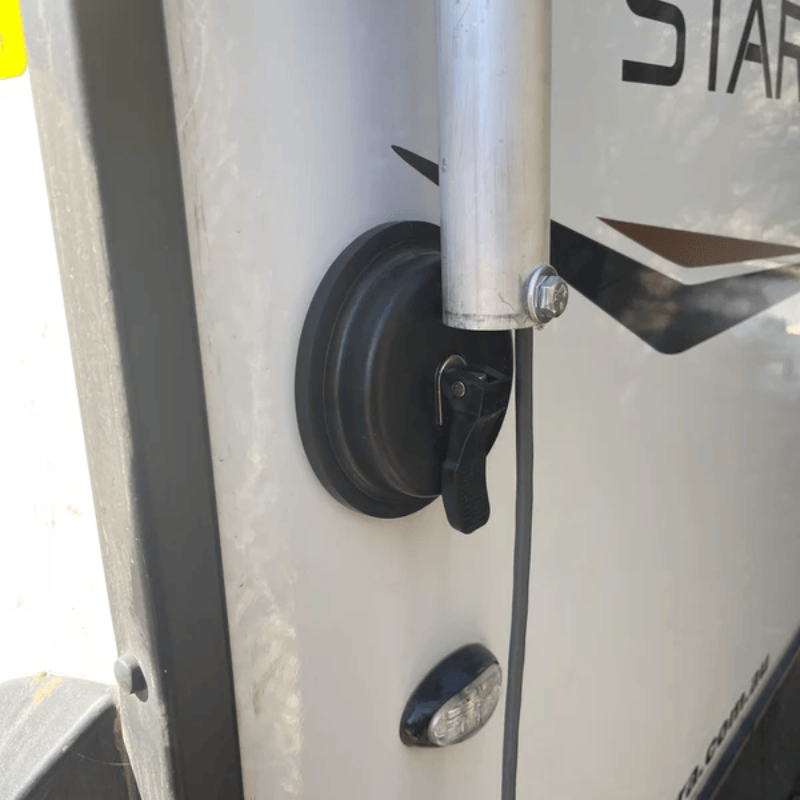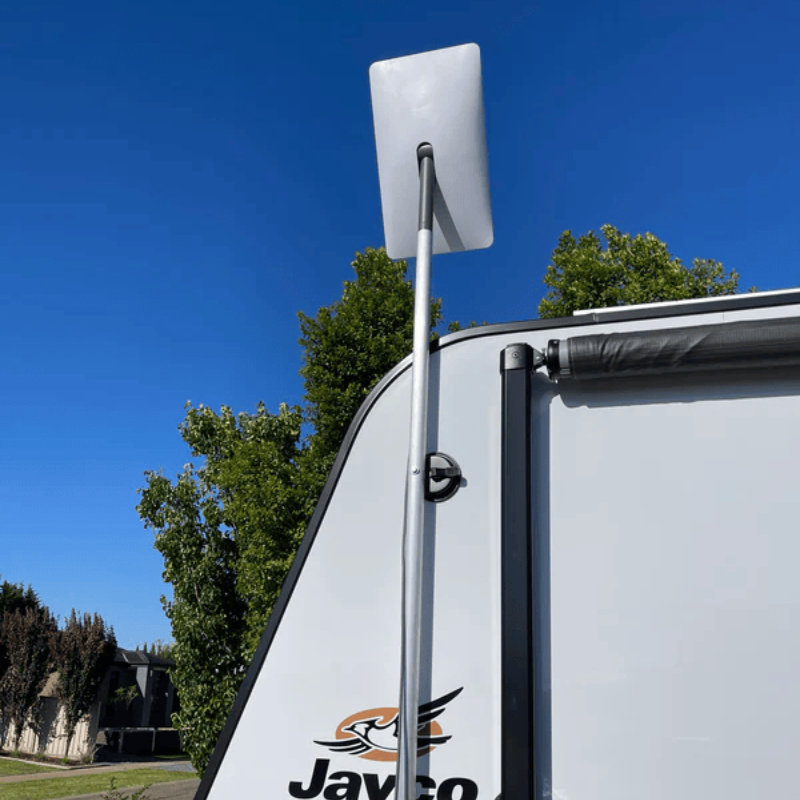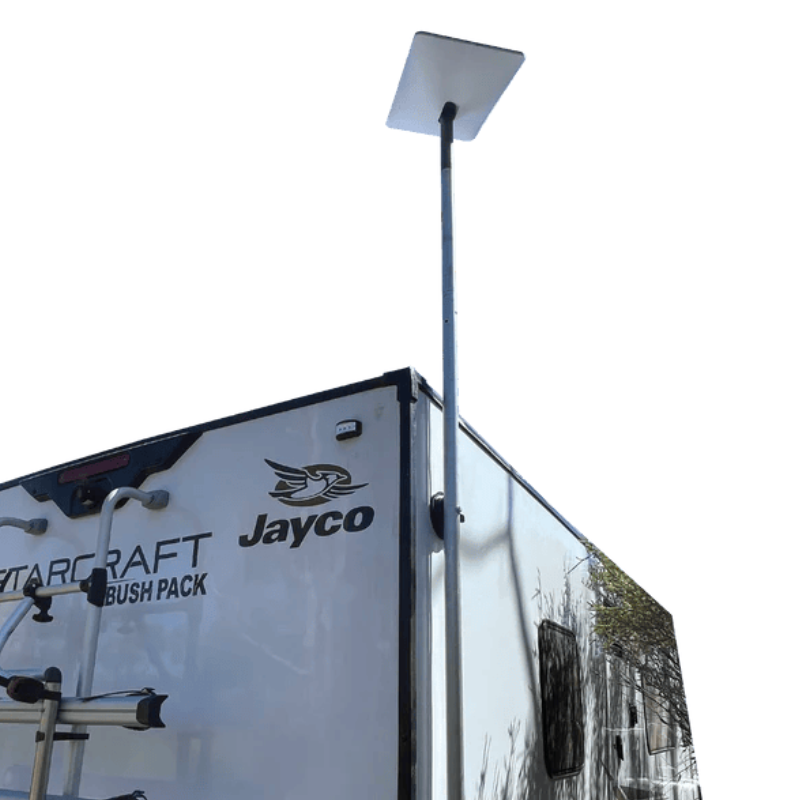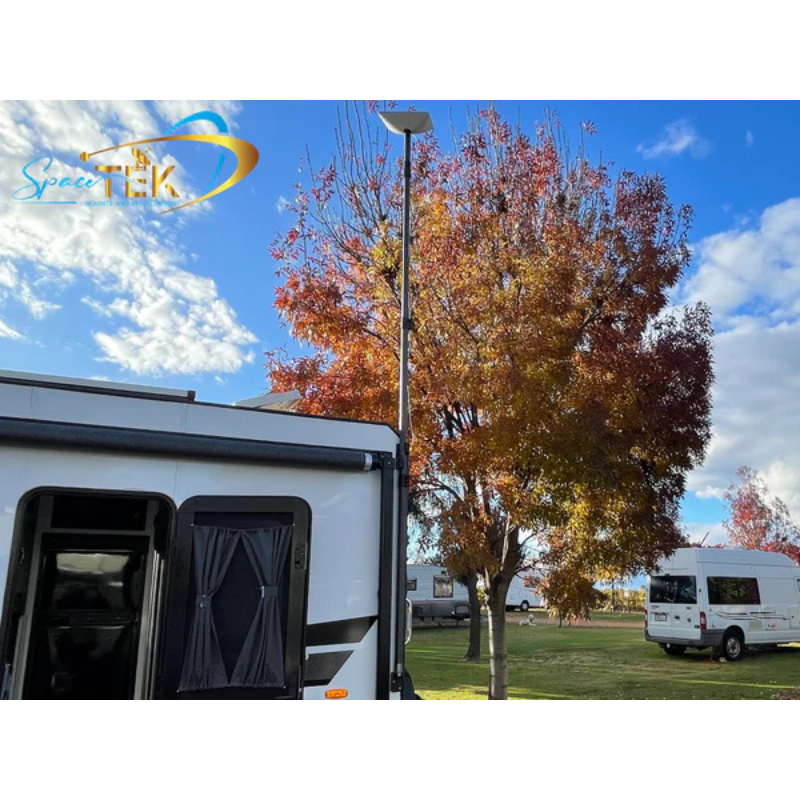Why Starlink RV Suction Cap Mounts Are Perfect for Australian Trips
Starlink RV Suction Cap Mount systems offer Australian travellers a flexible, damage-free way to stay connected across our vast continent. These portable mounting solutions use industrial-strength vacuum suction cups to secure your Starlink dish to smooth RV surfaces without drilling holes or permanent modifications.
Quick Overview of Starlink RV Suction Cap Mounts:
- Pull Strength: 120-210 lbs per 6-inch suction cup
- Compatible Models: Gen 2, Gen 3, and Mini dishes (with adapter)
- Wind Rating: Up to 65 km/h when properly installed
- Installation Time: 10-15 minutes initial setup, 5 minutes repositioning
- Weight: Approximately 1.5 kg for complete mount
- Price Range: $150-350 AUD depending on features
For Australian RVers exploring remote areas from the Red Centre to coastal highways, these mounts solve the challenge of maintaining reliable internet without compromising your vehicle's integrity. Whether you're working remotely from a national park or keeping kids entertained during long outback stretches, suction cap mounts provide the flexibility to optimise your Starlink positioning at every campsite.
The technology relies on vacuum-sealed industrial suction cups that create powerful adhesion to flat, non-porous surfaces. Unlike permanent roof installations that void warranties or magnetic mounts that can scratch paint, suction systems offer a completely reversible solution that's perfect for rental RVs or vehicles you plan to sell.
Australia's diverse conditions - from tropical humidity in Queensland to desert heat in the Northern Territory - demand mounting solutions built for extremes. Quality suction cap mounts incorporate UV-resistant materials and weather sealing to maintain reliable performance across our continent's challenging climate zones.
I'm Aaron Wroblewski, founder of SpaceTek Australia, and I've spent over 25 years developing satellite communication solutions specifically for Australian conditions. Through extensive testing across our unique landscape, I've seen how the right Starlink RV Suction Cap Mount can transform connectivity for remote workers, travelling families, and grey nomads exploring our beautiful country.
Understanding Starlink RV Suction Cap Mount Technology
Picture this: you're parked at a stunning campsite in the Grampians, but your Starlink dish needs to be positioned just right to avoid those towering eucalyptus trees. This is where the Starlink RV Suction Cap Mount truly shines, offering the flexibility that makes all the difference between frustrating dropouts and seamless connectivity.
The technology behind these mounts employs industrial-grade vacuum suction cups originally designed for moving massive glass panels in construction. Each 6-inch suction cup generates an impressive 120-210 lbs of pull strength when properly sealed - that's enough to support your entire Starlink dish several times over.
The magic happens through a simple but effective vacuum pump mechanism. When you pump the handle, you're creating a pressure differential that literally holds your dish in place through the power of atmospheric pressure. It's the same principle that keeps spacecraft sealed in the vacuum of space, just applied to keeping your internet connection stable on Earth.
What makes this particularly clever for Starlink users is how it addresses the unique requirements of low-Earth-orbit satellite communication. Unlike traditional satellite internet that uses geostationary satellites, Starlink's constellation moves across the sky, requiring an unobstructed view to maintain those fast speeds we all love. The Starlink RV Suction Cap Mount lets you reposition your dish at every campsite, working around local obstacles like trees, buildings, or even other RVs.
Modern suction cap mounts work seamlessly with all current Starlink models. Your Gen 2 and Gen 3 dishes attach directly to the mounting platform, while the compact Mini dish connects via a simple adapter. This means your mount investment stays valuable even if you upgrade your Starlink hardware down the track.
Why the Starlink RV Suction Cap Mount Keeps Your Dish Stable
The secret to reliable performance lies in the engineering of those industrial suction cups. The rubber compound maintains its flexibility whether you're camping in the tropical heat of Far North Queensland or the alpine chill of the Snowy Mountains. That 210 lb rating on premium cups provides serious holding power - with a safety factor of 4:1, you're still looking at over 50 lbs of effective grip per cup.
Your mount's vacuum indicator band acts like a built-in safety monitor. When this orange band becomes visible on the pump plunger, it's telling you the vacuum pressure has dropped below safe levels. Through extensive testing across Australia's diverse conditions, we've found that properly maintained suction cups hold their vacuum for weeks at a time, though a quick daily visual check gives you complete peace of mind.
The real genius is in the distributed load design. Quality mounts don't rely purely on suction to support your dish's weight. Instead, they incorporate safety brackets that bear the actual load, while the suction cups focus on maintaining precise positioning.
Key Components of a Quality Starlink RV Suction Cap Mount
The foundation of any reliable mount starts with its HDPE base - that's high-density polyethylene for those keeping track. This material choice offers exceptional impact resistance and UV stability that won't let you down under Australia's harsh sun or during dramatic temperature swings from scorching desert days to surprisingly cool nights.
Every piece of hardware needs to handle our coastal conditions, which is why quality mounts use rust-resistant materials throughout. Stainless steel bolts and anodised aluminium components maintain their strength even after weeks of salt spray during those perfect beach camping trips along our incredible coastline.
The safety lanyard might seem like a small detail, but it's your insurance policy during installation and removal. Nobody wants to watch their expensive Starlink dish take a tumble during setup - the lanyard prevents those heart-stopping moments and keeps everyone safe during roof-mounted installations.
Benefits of Suction Cap Mounts for Aussie RVers

Picture this: you pull into a brilliant campsite after eight hours behind the wheel. While your neighbours are still unpacking a toolbox and scanning cryptic instructions, your Starlink RV Suction Cap Mount has you online before the kettle whistles.
The secret is tool-free installation. No drilling, no warranty drama, and definitely no holes you will regret later. A well-made suction mount attaches in minutes and comes off just as quickly when it is time to hit the road again.
Zero drilling also protects resale value. Future buyers – or rental companies – prefer vehicles without extra holes or patched-up roofs. Because a suction mount leaves no trace, your RV stays pristine and any manufacturer warranty remains intact.
What really sets suction technology apart is instant repositioning. One towering gum tree can ruin a signal; shifting the dish a metre can rescue it. With a suction system you can move the dish in five minutes, ensuring a clear view of Starlink’s satellites every time you set up camp.
Remote workers see the biggest gains. Video calls from Uluru, file uploads from the Nullarbor or livestreams from Ningaloo Reef become realistic when you can fine-tune dish placement on the fly. Families enjoy seamless streaming and distance education, and grey nomads can stay in touch with doctors or grand-kids no matter where they roam.
Boondockers also love that suction mounts keep ground disturbance to a minimum. No tyre-under poles flattening grass, no guy-wires to trip over, and no metal stakes hammered into fragile soil. Many national parks now encourage low-impact setups like these.
Starlink for Remote Australia & Communities
For the outback, reliable internet is more than a convenience – it is lifeline infrastructure. Tele-health sessions replace days of driving to a clinic. Distance education keeps kids up to speed without leaving the station. Local businesses can finally run modern cloud software and accept online orders. Flexible mounts are the last piece of the puzzle, ensuring every dish has the clear sky Starlink needs to deliver low-latency broadband.
Driving & Weather Performance with a Suction Cap Mount
Quality mounts carry a 65 km/h wind rating when stationary, yet removal before highway travel remains smart insurance. Five minutes of effort protects your dish from buffeting and debris.
Rain actually helps the vacuum seal by increasing the pressure differential, while UV-inhibited rubber and HDPE prevent cracking under the fierce Australian sun. In short, a purpose-built suction system keeps you connected through heatwaves, tropical downpours and everything in between.
For more on portable setups, see this detailed guide.
Comparing Suction Caps to Other Mounting Options
When you're exploring Australia's vast landscapes, choosing the right mounting system can make or break your connectivity experience. I've tested virtually every mounting approach available, and each has its place depending on your travel style and priorities.
Ladder brackets work brilliantly if you want semi-permanent installation without touching your roof. They get your dish up high where it belongs, well above any roofline obstructions. The trade-off? You're locked into that position whether it's optimal for your current campsite or not. Plus, you'll need a sturdy ladder system to make this work properly.
Magnetic pads seem appealing for their simplicity, but they're frankly a bit risky for anything beyond quick tests. They can scratch paint, slide around in wind, and simply don't provide the holding power you need for Australia's challenging conditions. They're also useless on fibreglass surfaces, which rules out many modern RVs.
Tyre-under pole mounts offer incredible flexibility since they don't touch your vehicle at all. Perfect for rental RVs or when you want zero modifications. However, they're vulnerable to wind, curious wildlife, and uneven ground. I've seen too many dishes toppled by unexpected gusts or knocked over by curious cattle in remote areas.
Permanent roof installations provide rock-solid security and can handle highway speeds without removal. They're the gold standard for full-timers who prioritise performance above all else. The downside? You're committing to holes in your roof, potential warranty issues, and a setup that future buyers might not appreciate.
This is where Starlink RV Suction Cap Mounts find their sweet spot - offering professional-grade performance without permanent modifications.
Suction Cap Mount vs Ladder & Tyre Mounts
Height definitely goes to ladder mounts, positioning your dish well above potential obstructions. But here's what I've learned from years of testing: positioning flexibility often trumps pure height. With a suction mount, you can relocate your dish to the clearest section of roof at every campsite, optimising signal quality in ways that fixed ladder mounts simply can't match.
Speed limitations affect your travel routine differently with each system. Ladder mounts can typically stay attached during highway travel, whilst suction systems require a quick five-minute removal before hitting the road. Some travellers find this inconvenient, but I've found the removal process becomes second nature quickly.
Surface protection strongly favours suction systems. Ladder installations require drilling mounting holes that you'll live with forever, whilst tyre mounts can damage delicate campground surfaces or landscaping. Suction mounts leave absolutely no trace - crucial for maintaining good relationships with campground owners and preserving Australia's pristine camping areas.
Suction Cap Mount vs Permanent Installations
Warranty concerns make suction mounts particularly attractive for newer RVs. Permanent installations often void structural warranties, whilst suction systems preserve all manufacturer coverage. When you're dealing with a $200,000+ motorhome, maintaining warranty coverage isn't just smart - it's essential.
Resale value considerations heavily favour reversible solutions. Future buyers may view permanent modifications as damage rather than improvements. I've seen beautiful RVs with obvious patching where previous owners removed permanent mounts, significantly impacting resale appeal.
Ease of removal gives suction mounts an overwhelming advantage. Permanent installations require tools, sealant removal, and often leave holes requiring professional repair. Suction systems lift off cleanly in seconds, making them perfect for rental vehicles or when you're ready to sell. More info about RV roof revolution explores these considerations in greater detail, helping you understand the long-term implications of your mounting choice.
The beauty of quality suction systems lies in delivering permanent-mount performance with complete reversibility - the best of both worlds for Australian travellers.
Installation, Maintenance & Best Practices
Getting your Starlink RV Suction Cap Mount properly installed isn't rocket science, but attention to detail makes all the difference between a rock-solid setup and a dish that decides to take an unscheduled flight.
Surface preparation is where most installation issues begin - or end, if you do it right. Start with a thorough cleaning using isopropyl alcohol or quality glass cleaner to remove every trace of dirt, wax, road grime, and those mysterious sticky spots that seem to appear on RV roofs overnight. Even microscopic debris can create tiny leak paths that compromise your vacuum seal's integrity.
Here's a professional trick: the soapy water technique actually improves initial adhesion, particularly when you're dealing with Australia's high humidity conditions. Apply a thin film of soapy water to the suction cup surface before placement. This helps eliminate air bubbles during initial contact and creates a superior seal.
Daily vacuum checks become second nature once you establish the routine, and they take literally seconds. That orange indicator band on your vacuum pump isn't just decorative - it's your early warning system. When the band becomes visible, simply pump the handle until it disappears again.
Cable routing deserves careful attention because proper organisation prevents damage during dish repositioning. Use the provided cable clips to secure your Starlink cable along the mount structure, leaving adequate slack for adjustments while preventing snags or stress points that could damage the proprietary connector.
For premium RV finishes, paint protection film offers additional insurance against any potential surface marking. Applied to mounting areas before installation, these clear films protect your investment while maintaining that showroom appearance.
More info about Starlink RV suction cup mount uses provides comprehensive guidance on maximising both performance and longevity of your mounting system.
Step-by-Step Guide to Fitting Your Starlink RV Suction Cap Mount
The beauty of a quality suction cap mount lies in its five-minute setup process, though taking a few extra minutes for proper preparation pays dividends in reliability. Begin by selecting your mounting location using the Starlink app's obstruction tool to verify clear sky visibility.
Surface cleaning sets the foundation for success. Clean your chosen mounting area thoroughly with isopropyl alcohol, then allow it to dry completely. Any residual moisture can interfere with proper adhesion.
Position the suction cups on the clean surface, ensuring they sit completely flat without any rocking or gaps. Press down firmly to establish initial contact, then pump the vacuum mechanism until that orange indicator band completely disappears.
Attach your Starlink dish to the mounting platform, ensuring all locking mechanisms engage properly. The dish should sit rock-solid without any wobbling or movement when gently tested.
Route the cable through the provided clips, maintaining neat organisation while allowing enough slack for minor positioning adjustments.
Test your installation by gently attempting to lift the mount. Properly installed suction cups should hold firmly without any movement, creaking, or concerning sounds.
Long-Term Care to Prevent Surface Damage
Regular reseating every few weeks maintains optimal performance, particularly during extended stays in Australia's challenging conditions. Hot weather, high humidity, or dusty environments gradually degrade vacuum seals, making periodic maintenance essential for reliable operation.
Rotation of mounting location prevents permanent marking on sensitive surfaces while distributing wear patterns evenly. Moving the cups to slightly different positions every month or so ensures no single area bears continuous stress.
Gentle straight-off removal prevents surface damage when relocating or storing your mount. Resist the temptation to slide or twist the mount during removal - these motions can scratch even durable surfaces. Instead, break the vacuum seal by lifting one edge of each cup, then remove the entire mount using a straight pulling motion.
Real-World Performance Across Australian Conditions
Desert heat testing in Central Australia reveals how quality mounts perform under extreme conditions. Daytime temperatures exceeding 50°C test material limits, while overnight cooling creates thermal cycling that can stress seals and mounting hardware. Purpose-built mounts incorporate materials and designs that handle these extremes without degradation.
Coastal humidity presents different challenges, with salt-laden air accelerating corrosion of inferior hardware. Stainless steel components and anodised aluminium construction resist these conditions, maintaining structural integrity even after months of coastal camping.
Alpine frost conditions test flexibility and sealing properties at temperature extremes. Quality rubber compounds maintain elasticity even when frozen, ensuring reliable sealing when temperatures drop below freezing during mountain camping trips.
User anecdotes from across Australia consistently highlight the reliability of properly installed suction mounts. From Cape York to Tasmania, travellers report successful deployments in conditions ranging from tropical cyclones to alpine snow, demonstrating the versatility of this mounting approach.
How to Optimise Signal with a Suction Cap Mount in 2025
The Starlink app's obstruction tool becomes your primary planning resource for optimising dish placement. This feature shows exactly where satellites will appear in your local sky, helping you position the dish for maximum connectivity at each campsite.
Clear northern sky visibility remains crucial for Australian users, as Starlink satellites primarily appear in northern sky sectors from our southern hemisphere location. The flexibility of suction mounts allows you to optimise for this requirement at every stop.
Accessory upgrades can improve your overall Starlink experience. Quality routers, power management systems, and signal boosters work together with proper mounting to maximise performance. The key is building a complete system where each component supports the others.
Power-efficient router placement within your RV affects both performance and battery life during off-grid camping. Position your router centrally within the living space while maintaining good ventilation for heat dissipation. More info about staying online off-road covers system optimisation strategies.
Frequently Asked Questions about Starlink RV Suction Cap Mounts
Can I drive highways with my Starlink RV Suction Cap Mount attached?
While suction cap mounts are rated for winds up to 65 km/h, we strongly recommend removing the dish and mount before highway travel. The combination of wind buffeting, road vibration, and potential debris impact creates risks that outweigh the convenience of leaving the system attached.
The five-minute removal process is a small investment in protecting your expensive Starlink hardware. Many users develop efficient routines for quick removal and reinstallation, making this precaution practically painless while providing significant peace of mind.
Speed limits for attached mounts should be considered maximum ratings under ideal conditions. Real-world factors like crosswinds, passing trucks, and road surface conditions can create forces exceeding design limits. The conservative approach of removal protects both your equipment and other road users.
Will the Starlink RV Suction Cap Mount work with the Mini and Flat HP dishes?
Standard suction cap mounts accommodate Gen 2 and Gen 3 dishes directly, while the Mini dish requires a simple adapter. This adapter typically costs under $50 and provides secure mounting for the smaller dish format.
The Flat HP dish, designed for high-performance mobile applications, requires specialised mounting solutions due to its unique form factor and higher power requirements. Standard suction mounts aren't compatible with this premium dish model.
Model compatibility continues evolving as Starlink releases new hardware. Quality mount manufacturers typically offer adapter solutions for new dish formats, ensuring your mounting investment remains useful as technology advances.
How much weight can a Starlink RV Suction Cap Mount safely hold?
Pull ratings of 120-210 lbs per 6-inch suction cup provide substantial safety margins for Starlink dishes. Even the heaviest Gen 3 Standard dish weighs only 4.2 kg (9.2 lbs), meaning a four-cup mount provides over 20:1 safety factor under ideal conditions.
Safety margins account for real-world factors like partial vacuum loss, surface contamination, and dynamic loads from wind or vibration. The distributed load design of quality mounts ensures that even if one cup fails, the remaining cups maintain secure attachment.
Weight capacity calculations should include not just the dish but also any accessories like weather covers or cable management hardware. However, even with accessories, total system weight remains well within safe operating limits for properly installed suction mounts.
Stay Connected, No Matter Where You Are
Australia’s wide-open spaces are spectacular, but they are rough on gear. That is why SpaceTek designs every Starlink RV Suction Cap Mount with UV-resistant compounds, marine-grade hardware and vacuum systems proven from Cape York to the Snowy Mountains.
By choosing a reversible, no-drill solution you protect warranties, resale value and – most importantly – your connection. Whether you are running a business from the bush or keeping the family entertained on school holidays, a quality mount turns Starlink into a truly go-anywhere service.
Ready to upgrade your setup? Talk to the experts who build mounts specifically for Australian conditions via SpaceTek’s contact page. Invest once, travel far, and enjoy fast, reliable internet wherever the road takes you.




Leave a comment
This site is protected by hCaptcha and the hCaptcha Privacy Policy and Terms of Service apply.